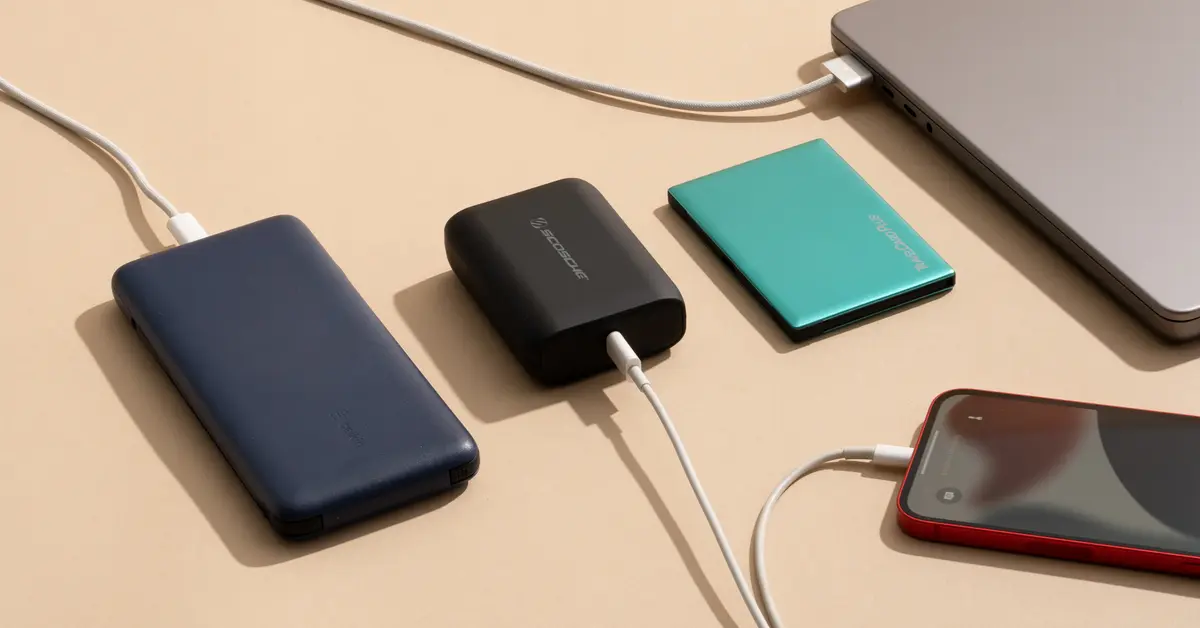Portable chargers have become an essential part of our daily lives, ensuring that we never again experience the frustration and inconvenience of a dead battery. Whether you’re traveling, working, or simply on-the-go, having a reliable source of power is crucial in this digital age. In this article, we will dive deep into the world of portable chargers, exploring their different types, factors to consider when choosing one, and tips and tricks for maximizing their lifespan. We will also uncover the latest technological advancements, such as fast charging and wireless options, as well as rugged and waterproof designs for outdoor enthusiasts. Join us as we glimpse into the future of portable charging with solar-powered and eco-friendly options. Get ready to unleash the potential of portable chargers and never be powerless again.
The Importance of Portable Chargers: Never Run Out of Battery Again
Always Stay Connected with a Portable Charger
Imagine being in the middle of an important phone call or trying to capture a breathtaking sunset on your camera when suddenly, your device runs out of battery. Frustrating, right? We’ve all been there. That’s where portable chargers come to the rescue. These compact devices are like a lifeline for your electronics, ensuring that you never run out of battery, no matter where you are. Whether you’re on a road trip, traveling, or even just spending a day out and about, having a reliable portable charger in your bag can save the day and keep you connected.
Unleash the Power of Portability
Gone are the days when we were tied to power outlets, waiting for our devices to charge. Portable chargers have revolutionized the way we stay powered up. With their small size and lightweight design, these chargers are like superheroes in your pocket, providing the freedom to charge your devices anytime, anywhere. Whether you’re camping in the wilderness or sitting at a bustling café, portable chargers allow you to stay connected without being tethered to a power source.
Understanding the Different Types of Portable Chargers: A Comprehensive Guide
Power Banks: The Versatile Chargers
One of the most common types of portable chargers is the power bank. These compact devices store electrical energy in built-in batteries, allowing you to charge your devices on the go. With various capacities available, you can find power banks that cater to your specific needs. From charging your smartphones and tablets to extending the battery life of your wearable devices, power banks are like a Swiss army knife for charging.
Solar Chargers: Harnessing the Sun’s Energy
If you’re an outdoor enthusiast or an eco-conscious individual, solar chargers are a great option for you. These chargers use solar panels to convert sunlight into electrical energy, providing a sustainable and renewable power source. While solar chargers may not offer the same charging speed as other portable chargers, they are an excellent backup for when you’re off the grid or in areas with limited access to electricity.
Wireless Chargers: Say Goodbye to Tangled Wires
Tired of dealing with tangled charging cables? Wireless chargers offer a convenient and clutter-free charging experience. These chargers use electromagnetic fields to transfer power from the charger to your device, eliminating the need for cables. Simply place your device on the charging pad, and it starts charging. While wireless chargers may not be as portable as power banks, they provide a sleek and hassle-free way to charge compatible devices.
[amazon bestseller=”Portable Chargers” items=”10″]
Factors to Consider when Choosing a Portable Charger: Capacity, Size, and Compatibility
Capacity: Power to Keep You Going
When selecting a portable charger, one of the crucial factors to consider is its capacity, measured in milliampere-hours (mAh). The higher the capacity, the more charges or extended battery life it can provide. Consider the power needs of your devices and choose a charger that can accommodate them. For instance, if you frequently use power-hungry gadgets or plan to charge multiple devices simultaneously, opting for a high-capacity charger is a wise decision.
Size and Portability: Balancing Convenience and Power
Portable chargers come in various sizes, ranging from small keychain-sized chargers to larger brick-like options. Before making a choice, think about how important portability is to you. If you require a charger that fits in your pocket or purse, smaller-sized power banks may be the way to go. On the other hand, if you prioritize having an extended power supply, you might consider a larger charger, sacrificing some portability for extra capacity.
Compatibility: Ensuring Seamless Charging
Another key aspect to consider is the compatibility of the portable charger with your devices. Different chargers offer varying output voltage and amperage, so it’s important to choose one that matches the requirements of your devices. For instance, if your device supports fast charging, make sure the charger also supports the same technology to maximize charging efficiency. Additionally, some chargers may come with multiple ports and cables, allowing you to charge multiple devices simultaneously and minimize the need for additional accessories.
Charging on the Go: Tips and Tricks for Maximizing the Lifespan of Your Portable Charger
Utilize Power-Saving Modes
To make the most out of your portable charger’s capacity, utilize the power-saving modes available on your devices. Lowering screen brightness, disabling unnecessary notifications, and closing background apps can significantly reduce power consumption, allowing your charger to provide more charges during a single charge cycle.
Keep an Eye on Temperature
Extreme temperatures can negatively impact the performance and lifespan of your portable charger. Avoid exposing your charger to direct sunlight or storing it in excessively hot or cold environments. High temperatures can cause the batteries to degrade faster, while low temperatures can reduce the overall capacity. By keeping your charger within the recommended temperature range, you can ensure its longevity and optimal performance.
Proper Maintenance
Portable chargers, like any electronic device, require proper maintenance to perform at their best. Regularly clean the charging ports and cables to remove dust and debris, as it can affect charging efficiency. Additionally, store your charger in a safe and dry place to prevent any accidental damage, such as water exposure. By taking care of your portable charger, you can ensure its longevity and reliability whenever you need it.
The Importance of Portable Chargers: Never Run Out of Battery Again
Portable chargers have become a necessity in our increasingly digitized lives. Picture this: you’re out and about, relying on your smartphone for various tasks and entertainment when suddenly, your battery level drops dangerously low. Panic sets in as you frantically search for an outlet or a place to charge your device. But with a portable charger in your pocket or bag, this anxiety-inducing scenario becomes a thing of the past.
The Lifeline of Modern Life
In today’s world, smartphones are more than just communication devices – they have become an extension of ourselves. From capturing precious memories to accessing important information and staying connected with loved ones, we heavily rely on our smartphones. But what good is a smartphone with a dead battery?
Portable chargers are like an extra lifeline for our devices. They provide the power we desperately need when we’re on the move, allowing us to stay connected, entertained, and productive without interruptions. With a portable charger by your side, you can bid farewell to the frustration of a drained battery and embrace the freedom to use your devices whenever and wherever you want.
Unleashing your Wanderlust
For the adventurers and wanderers out there, portable chargers are nothing short of a game-changer. Imagine exploring a new city, relying on your smartphone for navigation, capturing breathtaking photos, and sharing your experiences on social media. Without a reliable source of power, these adventures could be marred by anxiety about battery life. But with a portable charger, you can embrace your wanderlust with confidence, knowing that your devices will never let you down.
Understanding the Different Types of Portable Chargers: A Comprehensive Guide
With a myriad of options available in the market, it’s crucial to understand the different types of portable chargers to determine which one suits your needs best. Let’s delve into the world of portable chargers and explore the various options available:
Power Banks: The Go-to Choice
Power banks are the most common and versatile type of portable chargers. They come in a wide range of capacities, typically measured in milliampere-hours (mAh). These compact devices can be easily carried in your bag or pocket, allowing you to charge your smartphone or other devices on the go. Consider your usage patterns and the number of devices you need to charge simultaneously when choosing a power bank.
Solar Chargers: Harnessing the Power of the Sun
If you’re an outdoor enthusiast or someone who values sustainability, solar chargers might be your ideal choice. These innovative devices generate electricity from sunlight, converting it into energy to charge your devices. While solar chargers are an eco-friendly option, it’s important to note that their charging speed may be slower compared to other alternatives. They work best when used in ample sunlight, making them perfect companions for camping trips and outdoor adventures.
Wireless Chargers: No Cables, No Hassle
Tired of tangled cables and the hassle of finding an outlet? Wireless chargers provide a convenient solution. These chargers use electromagnetic fields to transfer energy between the charger and your device, eliminating the need for a physical connection. Simply place your smartphone on the charging pad, and voila – your device starts charging wirelessly. Keep in mind that wireless chargers require compatible devices, so check if your smartphone supports wireless charging before investing in one.
Factors to Consider when Choosing a Portable Charger: Capacity, Size, and Compatibility
When selecting a portable charger, it’s essential to consider specific factors to ensure it meets your requirements. Let’s explore the key considerations:
Capacity: Power to Keep You Going
The capacity of a portable charger is measured in milliampere-hours (mAh) and dictates how much energy it can store. Higher capacity chargers can provide more charges for your devices before needing to be recharged themselves. Consider your power consumption needs and how frequently you’ll have access to charging opportunities when choosing a capacity that suits you.
Size and Portability: On-the-Go Convenience
Portability is a vital aspect when it comes to portable chargers. After all, the whole point is to have a convenient power source while you’re on the move. Consider the size, weight, and form factor of the charger to ensure it fits seamlessly into your lifestyle. Compact and lightweight chargers are particularly ideal for travel and everyday use.
Compatibility: Powering Your Devices
Before making a purchase, ensure that the portable charger you choose is compatible with your devices. Check the charger’s specifications to see if it supports the charging needs of your smartphones, tablets, or other gadgets. Some chargers even offer multiple ports or versatile connectivity options, accommodating different devices and charging requirements.
Charging on the Go: Tips and Tricks for Maximizing the Lifespan of Your Portable Charger
To make the most out of your portable charger, consider these tips and tricks to optimize its performance and lifespan:
Charge-Up Regularly
Just like your smartphone, your portable charger needs regular charging to stay powered up. Get into the habit of charging your portable charger whenever an outlet is available, so you always have a reliable source of backup power.
Handle with Care
Portable chargers are built to endure the demands of travel, but they still require proper handling to ensure their longevity. Avoid exposing them to extreme temperatures, moisture, or unnecessary physical stress. Treat your portable charger as a valuable companion, and it will serve you faithfully.
Keep an Eye on Indicators
Many portable chargers come equipped with LED indicators that provide useful information about their battery level or charging status. Familiarize yourself with these indicators to gauge the remaining power of your charger accurately. This knowledge ensures you can recharge it promptly before running out of juice.
Use Energy-Efficient Cables
When charging your devices with a portable charger, consider using high-quality, energy-efficient cables. These cables minimize power loss, ensuring that the energy from your charger is efficiently transferred to your devices. Opt for cables with thick, durable insulation to protect against wear and tear, maximizing their lifespan as well.
Portable chargers are a true lifesaver in our fast-paced, technology-driven lives. These compact power banks, solar chargers, and wireless chargers empower us with the freedom to keep our devices charged on the go. By understanding the different types of portable chargers, considering factors such as capacity and compatibility, and adopting smart charging practices, you can make the most of your portable charger and never find yourself stranded with a dead battery again.
Conclusion
In a world driven by technology, the demand for reliable power sources has never been more essential. Portable chargers have emerged as the ultimate solution, ensuring you never run out of battery again. As we’ve explored throughout this comprehensive guide, understanding the different types, considering key factors, and maximizing the lifespan of your device are crucial steps to finding the perfect portable charger. With the latest advancements in fast charging and wireless options, as well as rugged designs for outdoor enthusiasts, portable chargers continue to evolve and cater to our diverse needs. As we look towards the future, solar-powered chargers and eco-friendly options hold the promise of sustainable and environmentally conscious power solutions. So whether you’re an adventurer on the go or a tech-savvy individual, embrace the convenience and power of portable chargers to stay connected in a world that never stops.
Frequently Asked Questions
1. How do portable chargers work?
Portable chargers, also known as power banks, work by storing electrical energy in a battery pack. When your device’s battery is running low, you can connect it to the portable charger using a USB cable. The charger then transfers stored power to your device, effectively recharging its battery.
2. What factors should I consider when choosing a portable charger?
When choosing a portable charger, there are several factors to consider. The first is capacity, which is measured in milliampere-hours (mAh). Higher capacity chargers can provide more charges, but they are generally bulkier and heavier. You should also look for output voltage and current specifications that match your device’s requirements. Portability, build quality, and additional features like multiple ports or fast charging compatibility should also be taken into account.
3. Can portable chargers damage my devices?
No, portable chargers are designed to be safe for your devices when used properly. Most reputable chargers have built-in safety features like overcharge protection, short circuit protection, and temperature control to prevent damage. However, it is always advisable to choose reliable, certified chargers from reputable manufacturers and follow the product instructions carefully.
4. How long does it take to charge a device using a portable charger?
The charging time can vary depending on the capacity of the power bank and the device being charged. As a general rule, charging time is influenced by the charging speed (measured in amps) and the device’s battery capacity. For example, a higher capacity power bank with fast-charging capabilities can charge most smartphones from 0-100% in 1-2 hours. However, it’s important to note that some devices may have limitations on the charging speed due to their hardware or software.
5. Are portable chargers allowed on airplanes?
Yes, portable chargers are typically allowed on airplanes, both in carry-on luggage and checked bags. However, regulations may vary between airlines and countries, so it’s always best to check with the specific airline before traveling. In general, it’s recommended to carry portable chargers in your carry-on baggage to prevent potential damage from rough handling in checked luggage.











